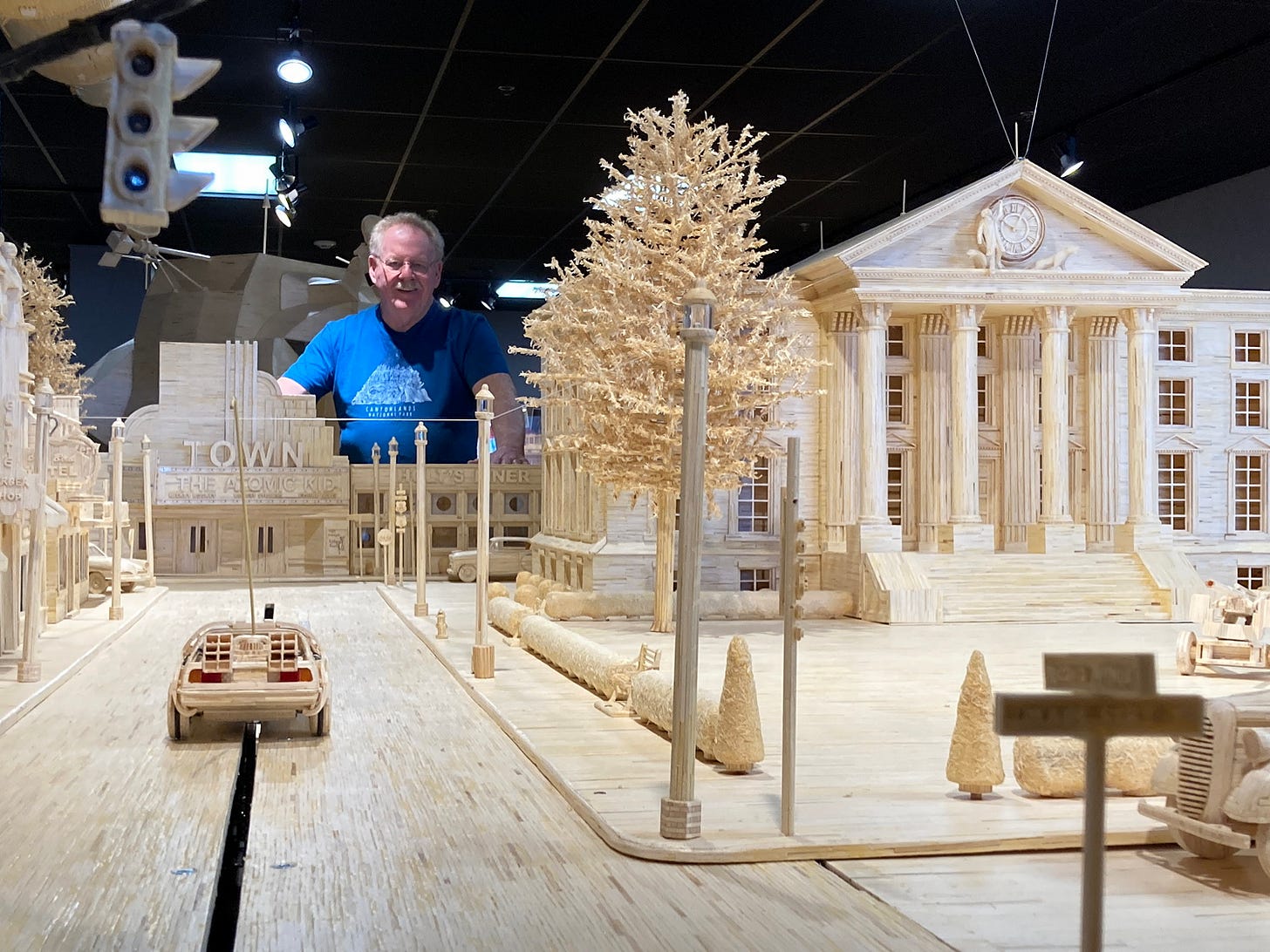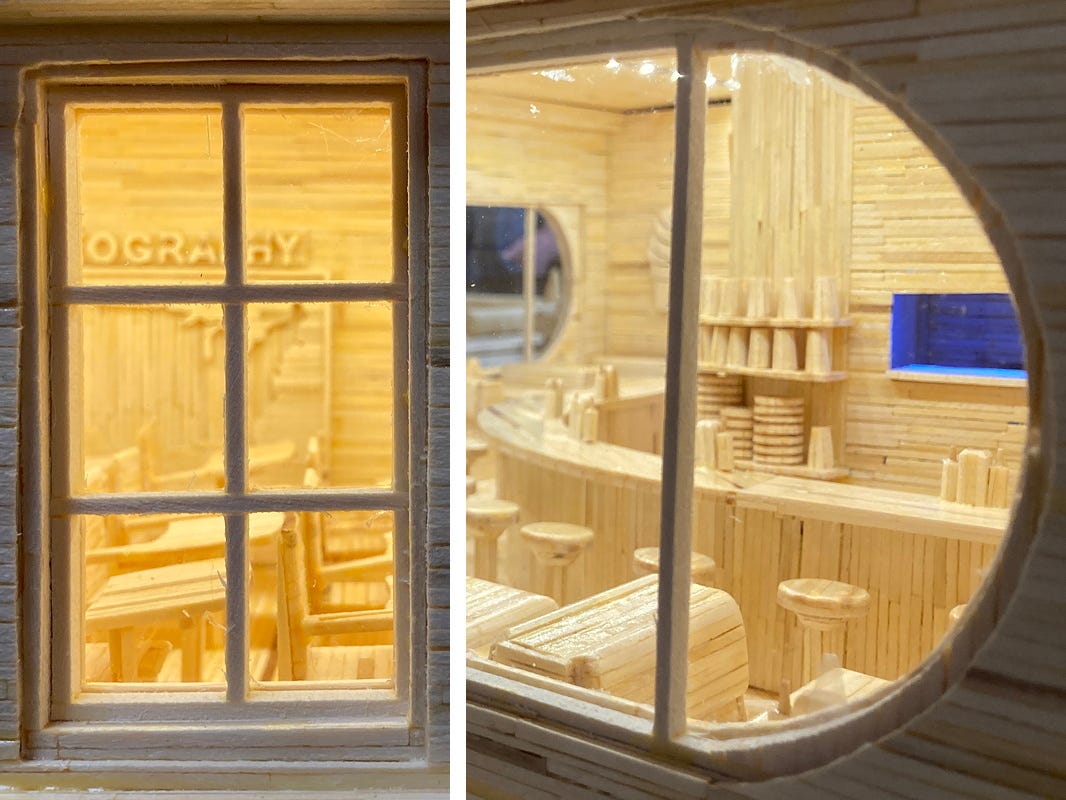
GLADBROOK, Iowa/HILL VALLEY, California — Great Scott! Pat Acton has done it again!
The “Matchstick Marvels” maven has wrapped up what by his count is his 79th creation. Unlike the other models on display at the museum in Gladbrook, including the U.S. Capitol and many military and space craft, this one is a diorama.
It’s Courthouse Square at the climax of the film “Back to the Future,” when Marty McFly drives a DeLorean time machine up to 88 mph to return to the year 1985.
The Hill Valley set is Acton’s largest by square footage — 16 feet long by 9.5 feet deep — but not in number of matchsticks used. Acton estimates around 723,000 matchsticks went into the set, which took 16 months to build. The courthouse, the largest piece of the set, is about 2 feet tall, with “Doc” Emmett Brown right beside the iconic clock.
Acton made the set as his final contracted piece for “Ripley’s Believe It or Not!” The entertainment franchise that started with a comic in 1918 has bought many pieces from Acton to show off in its museums. Ripley’s presented Acton with a list of movie set pieces to choose from and he selected “BTTF,” which offered him a chance to play with architecture, science fiction, classic cars and, crucial to the set and movie, electricity.
You built a town square … out of matchsticks?
The real Courthouse Square is part of the Universal Studios backlot in Hollywood. It’s used for the first episode of “The Twilight Zone.” The gas station made a recent appearance in the “Quantum Leap” reboot.
But the square is most strongly associated with the time-travel trilogy from Robert Zemeckis and Robert Gale. Acton used storyboards from the movie, along with photos and a few viewings, to get his bearings and went to work.
The square is faithfully reconstructed, with a bit of artistic license, for the 1955 “BTTF” experience. Hill Valley High School is behind the courthouse. Biff Tannen’s 1946 Ford and the manure truck he drives into during a chase scene are parked downtown. There are highway signs for U.S. 395 and U.S. 8 (a reproduction of the real-life movie goof; U.S. 8 is almost entirely in Wisconsin).
Acton started making models in 1977 by cutting the tips off store-bought matchsticks and eventually progressed to ordering them straight from the manufacturer. He figured out 15 years later that he could glue together “walls” of sticks on Plexiglass, let the glue dry and then have a full panel. “I’m building plywood out of matchsticks,” he said. That permitted easy creation of the streets, courthouse and buildings’ walls here. The pillars are built up around plastic discs and dowels to hold the shape. All the surfaces are sanded down and varnished.
It’s the details in every model where Acton really shines, and this is no exception. “Welcome to Hill Valley” has all the civic organization signs. The diner has plates and condiment bottles. The high school is fully furnished, with a chemistry lab and library, ready for tiny students to walk into.

“I spent a lot of time shelving books” in that library, Acton said, even though it and the classrooms can only be seen with close looks if at all.
The real challenge was making trees, which he had never done before. A lot of matchstick shavings and a lot of work with tinsnips yielded needles for the evergreens. The cars took longer to make than the entire side of the street in the back of the display. He used plastic or die-cast models as reference, then built from the frames up.
The set has a few Easter eggs. There’s a sly reference to Iowa Hawkeyes and Chicago Bulls basketball player B.J. Armstrong. A 1953 Studebaker Commander and 1953 Chevrolet Bel Air reference Acton’s birth year. There’s a 1955 Bel Air, too.
But only in Hill Valley on Nov. 12, 1955, could a pair of Bel Airs be outdone by a souped-up 1981 DeLorean DMC-12.

One-point-twenty-one gigawatts!
“I’ve gotten pretty good with electronics in the past 10 years,” Acton said.
The set is fully electrified. There are 22 streetlights and a working stoplight. The car lift in the gas station moves a 1953 Corvette up and down. The control panel’s buttons light up different buildings, each with its own song clip. “Earth Angel,” “Johnny B. Goode,” and “Back in Time” are all here.
Acton’s time machine doesn’t have a flux capacitor, but it will have a linear actuator. When that’s installed, the car will be able to move down the street. Fiber-optic lines play the role of the lightning striking the clock tower, channeled down to the street, where LED strips make the fire trails left behind when McFly goes back to the future.
The size limitations of the workshop in his basement work in Acton’s favor — the pieces must be able to be disassembled and portable enough to move through regular doors.
Acton will keep creating “until my breath or the matchsticks run out.” The approximately 2 million matchsticks Acton has left are the last. They’re not made in the United States anymore.
He had long planned to make a Disney castle, but is now tilting toward an Imperial Star Destroyer from “Star Wars” instead. Whatever he makes next, it will stay in Gladbrook.
The “Back to the Future” set will be in Gladbrook at the Matchstick Marvels museum every afternoon from April 1 to Oct. 1, when it’s shipped off to Ripley’s. But now, Acton is off the clock.
He has some time on his hands.
My other work can be found on my website, Iowa Highway Ends, and its blog.
I am proud to be part of the Iowa Writers’ Collaborative. If you’re interested in commentary by some of Iowa’s best writers, please follow your choice of Collaborative members:





👍
Wow, I never would have known about this! Thank you!